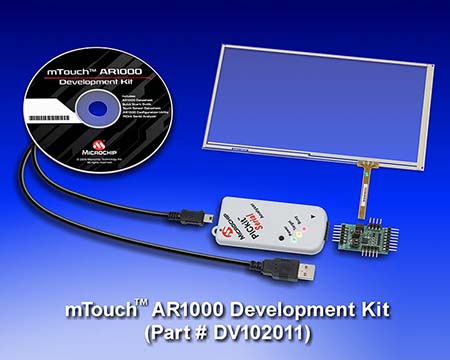[Editor's Note: This was originally posted on Low-Power Design]
Plans are made to be changed. The first touch development kit I am working with is the Microchip mTouch AR1000 Touch Screen Controller. I did work with the kit on an XP host, but I am delaying writing about the details of the bench exercise because the 64-bit support is scheduled to be available within the next few weeks. I plan to repeat my bench testing with the 64-bit update and combine what I observe with this development kit in a single upcoming post.
The mTouch AR1000 development kit consists of a controller development board, a 7” four-wire resistive touch screen, and a PICkit serial analyzer. I will describe the resistive (as well as capacitive and inductive) touch technology, in a separate post so that I can refer to it in the write-up for any other similar kits. The figure shows the components and the connection points between each of them. The development kit provides power to the sensor and controller through a USB connection with the host. When using this kit, you need to avoid connecting the host USB through a hub to ensure that enough power is supplied to the kit.
The controller is capable of supporting 4-, 5-, and 8-wire resistive touch sensors. The kit includes a 7” four-wire sensor; four-wire sensors represent the largest volume of the resistive touch sensors in the market. I printed the included calibration and POS (point of sale) templates on a piece of paper and placed it under the sensor. The controller board supports SPI and I2C interface connections to send touch sensor data to the embedded target or host processor. The touch data messages consist of pen up, pen down, and an (X, Y) coordinate for a single touch point; if you touch the sensor in more than one location, such as multiple fingers or even your palm, the touch message coordinates will report a single “averaged” location of the touches. The (X, Y) coordinates are auto-scaled across 1024 points along each axis. The controller updates the touch state data as fast as the sensor can support; the included sensor supports 100 to 130 samples per second. The controller provides a first-order filtering of the touch data.
In the next post, I will explain the strengths and trade-offs when using resistive touch sensors followed by a post detailing my experience with this kit on a host running XP and 64-bit operating system. If you would like to participate in this project, post here or email me at Embedded Insights.
Tags: Touch Screens

